Experimental and Numerical Study on Shear Resistance of Notched Perfobond Shear Connector
Abstract
:1. Introduction
2. Experimental Investigations
2.1. Test Program
2.2. Layout of Test Specimen
2.3. Details of Perfobond Ribs
2.4. Material Properties
2.5. Test Setup and Instrumentation
3. Finite Element Analysis
3.1. General
3.2. Finite Element Type and Mesh
3.3. Interaction and Boundary Conditions
3.4. Material Modeling of Concrete
3.5. Material Modeling of Steel
4. Analysis Results and Verification
4.1. Failure Mode
4.2. Load–Slip Behavior
4.3. Load Transfer Mechanism
5. Parametric Study
5.1. Effect of Hole Diameter
5.2. Effect of Hole Distance
5.3. Effect of Hole Number
5.4. Effect of Cut Width
5.5. Effect of Perfobond Thickness
5.6. Effect of Concrete Strength
5.7. Effect of Rebar Diameter
5.8. Effect of Rebar Strength
5.9. Effect of Steel Strength
6. Prediction of Shear Capacity
6.1. Previous Expressions
6.2. Proposed Expression
6.3. Comparison and Validation
7. Conclusions
- (1)
- The push-out failure modes of perfobond shear connectors with circular and notched holes are characterized by crack in the concrete slab, yield of the perforating rebar and shear failure of the concrete dowel. The concrete crack initially occurs near the perfobond shear connectors and spreads out across the concrete slab. The rebar in the hole yields at the locations of perforation due to large deformations. The concrete dowels in the hole fails in shear. There is no obvious deformation in the conventional perfobond rib. In comparison, the notched perfobond rib deforms with the cut width increased.
- (2)
- The accuracy of the proposed finite element method is verified by comparison with push-out test results. When the global mesh sizes were 10 mm, 15 mm and 20 mm, the analyzed shear capacities of conventional perfobond shear connectors accounted for 101%, 111% and 117% of the mean test results, respectively, while those of notched perfobond shear connectors took up 97%, 102% and 105% of the mean tested shear capacities. The proposed finite element model can be used to generate reasonable analysis results for both conventional and notched perfobond shear connectors with the overall element size of 10 mm.
- (3)
- In total, 43 finite element models of push-out tests were generated to evaluate the shear capacity of notched perfobond shear connectors. The shear capacity could be increased by 38% by increasing the perfobond thickness from 12 mm to 30 mm, by 43% by increasing the concrete strength from 30 MPa to 70 MPa, by 37% by increasing the steel strength from 235 MPa to 460 MPa. The hole diameter, the cut width, the rebar diameter and the rebar strength have little effect on the shear capacity of notched perfobond shear connectors.
- (4)
- Based on nonlinear finite element simulations of notched perfobond shear connectors, increasing the hole distance from 100 mm to 300 mm leads to an increase in the average shear capacity by 30%. The reason might be that narrower hole distances result in smaller steel stems between the holes which easily get fractured before the shear failure of the concrete dowel. The hole distance is suggested to be no smaller than 200 mm to prevent the steel fracture between the adjacent holes.
- (5)
- The increase of the hole number from one to five leads to a decrease in the average shear capacity of the notched perfobond shear connector by 41%. The main reason is that the shear loads are unevenly distributed among the multi-holes in the longitudinal direction. The holes at two ends of the perfobond rib bear greater loads than the holes at the middle. The average shear capacity of the multi-hole notched perfobond shear connector is smaller than that of the single-hole notched perfobond shear connector.
- (6)
- An analytical model is proposed to evaluate the shear capacity per hole of notched perfobond shear connectors. Compared with the existing equations, the predicted shear capacities from the proposal in this study agree reasonably well with the experimental and numerical results, and thus may be used to estimate the shear capacity of notched perfobond shear connectors. Further experimental studies are required to extend the scope of the proposed shear capacity equation in steel and concrete composite structures.
Author Contributions
Funding
Conflicts of Interest
References
- Li, Y.; Cai, C.S.; Liu, Y.; Chen, Y.; Liu, J. Dynamic analysis of a large span specially shaped hybrid girder bridge with concrete-filled steel tube arches. Eng. Struct. 2016, 106, 243–260. [Google Scholar] [CrossRef]
- Xue, D.; Liu, Y.; He, J.; Ma, B. Experimental study and numerical analysis of a composite truss joint. J. Constr. Steel Res. 2011, 67, 957–964. [Google Scholar] [CrossRef]
- Kim, Y.H.; Kang, J.Y.; Kim, S.H.; Kim, D.J. Structural performance of steel pile caps strengthened with perfobond shear connectors under lateral loading. Appl. Sci. 2016, 6, 317. [Google Scholar] [CrossRef]
- Kim, K.S.; Lee, D.H. Flexural behavior of prestressed composite beams with corrugated web: Part II. Experiment and verification. Compos. Part B Eng. 2011, 42, 1617–1629. [Google Scholar] [CrossRef]
- Mirza, O.; Uy, B. Effects of the combination of axial and shear loading on the behaviour of headed stud steel anchors. Eng. Struct. 2010, 32, 93–105. [Google Scholar] [CrossRef]
- Ataei, A.; Bradford, M.A.; Liu, X. Experimental study of composite beams having a precast geopolymer concrete slab and deconstructable bolted shear connectors. Eng. Struct. 2016, 114, 1–13. [Google Scholar] [CrossRef]
- Zheng, S.; Zhao, C.; Liu, Y. Experimental shear strength evaluation of perfobond shear connector with various hole shapes. Struct. Eng. Mech. 2018, 67, 131–142. [Google Scholar] [CrossRef]
- Zheng, S.; Zhao, C.; Liu, Y. Analytical model for load–slip relationship of perfobond shear connector based on push-out test. Materials 2019, 12, 29. [Google Scholar] [CrossRef]
- Kim, S.H.; Kim, K.S.; Lee, D.H.; Park, J.S.; Han, O. Analysis of the shear behavior of stubby Y-type perfobond rib shear connectors for a composite frame structure. Materials 2017, 10, 1340. [Google Scholar] [CrossRef] [PubMed]
- Classen, M.; Herbrand, M.; Kueres, D.; Hegger, J. Derivation of design rules for innovative shear connectors in steel-concrete composites through the systematic use of non-linear finite element analysis (FEA). Struct. Concr. 2016, 17, 646–655. [Google Scholar] [CrossRef]
- Lorenc, W.; Kożuch, M.; Rowiński, S. The behaviour of puzzle-shaped composite dowels—Part I: Experimental study. J. Constr. Steel Res. 2014, 101, 482–499. [Google Scholar] [CrossRef]
- Gattesco, N.; Giuriani, E.; Gubana, A. Low-cycle fatigue test on stud shear connectors. J. Struct. Eng. ASCE 1997, 123, 145–150. [Google Scholar] [CrossRef]
- Leonhardt, F.; Andrä, W.; Andrä, H.P.; Harre, W. New advantageous shear connection for composite structures with high fatigue strength. Beton Stahlbetonbau 1987, 82, 325–331. [Google Scholar] [CrossRef]
- Oguejiofor, E.C.; Hosain, M.U. Numerical analysis of push-out specimens with perfobond rib connectors. Comput. Struct. 1997, 62, 617–624. [Google Scholar] [CrossRef]
- Hosaka, T.; Mitsuki, K.; Hiragi, H.; Ushijima, Y.; Tachibana, Y.; Watanabe, H. An experimental study on shear characteristics of perfobond strip and its rational strength equations. J. Struct. Eng. JSCE 2000, 46A, 1593–1604. [Google Scholar]
- Ahn, J.H.; Lee, C.G.; Won, J.H.; Kim, S.H. Shear resistance of the perfobond-rib shear connector depending on concrete strength and rib arrangement. J. Constr. Steel Res. 2010, 66, 1295–1307. [Google Scholar] [CrossRef]
- Zheng, S.; Liu, Y.; Yoda, T.; Lin, W. Parametric study on shear capacity of circular-hole and long-hole perfobond shear connector. J. Constr. Steel Res. 2016, 117, 64–80. [Google Scholar] [CrossRef]
- EN 1994–1–1:2004. Eurocode 4: Design of Composite Steel and Concrete Structures, Part 1–1: General Rules and Rules for Buildings; European Committee for Standardization (CEN): Brussels, Belgium, 2004. [Google Scholar]
- ABAQUS Documentation; Version 6.10; Dassault System: Providence, RI, USA, 2010.
- FIB. Model Code 2010—Final Draft, Volume 1; FIB: Lausanne, Switzerland, 2010. [Google Scholar]
- Nguyen, H.T.; Kim, S.E. Finite element modeling of push-out tests for large stud shear connectors. J. Constr. Steel Res. 2009, 65, 1909–1920. [Google Scholar] [CrossRef]
- Hordijk, D.A. Tensile and tensile fatigue behaviour of concrete; experiments, modelling and analyses. Heron 1992, 37, 3–79. [Google Scholar]
- Birtel, V.; Mark, P. Parameterised finite element modelling of RC beam shear failure. In Proceedings of the 19th Annual International ABAQUS Users’ Conference, Boston, MA, USA, 23–25 May 2006; ABAQUS Inc.: Boston, MA, USA, 2006; pp. 95–108. [Google Scholar]
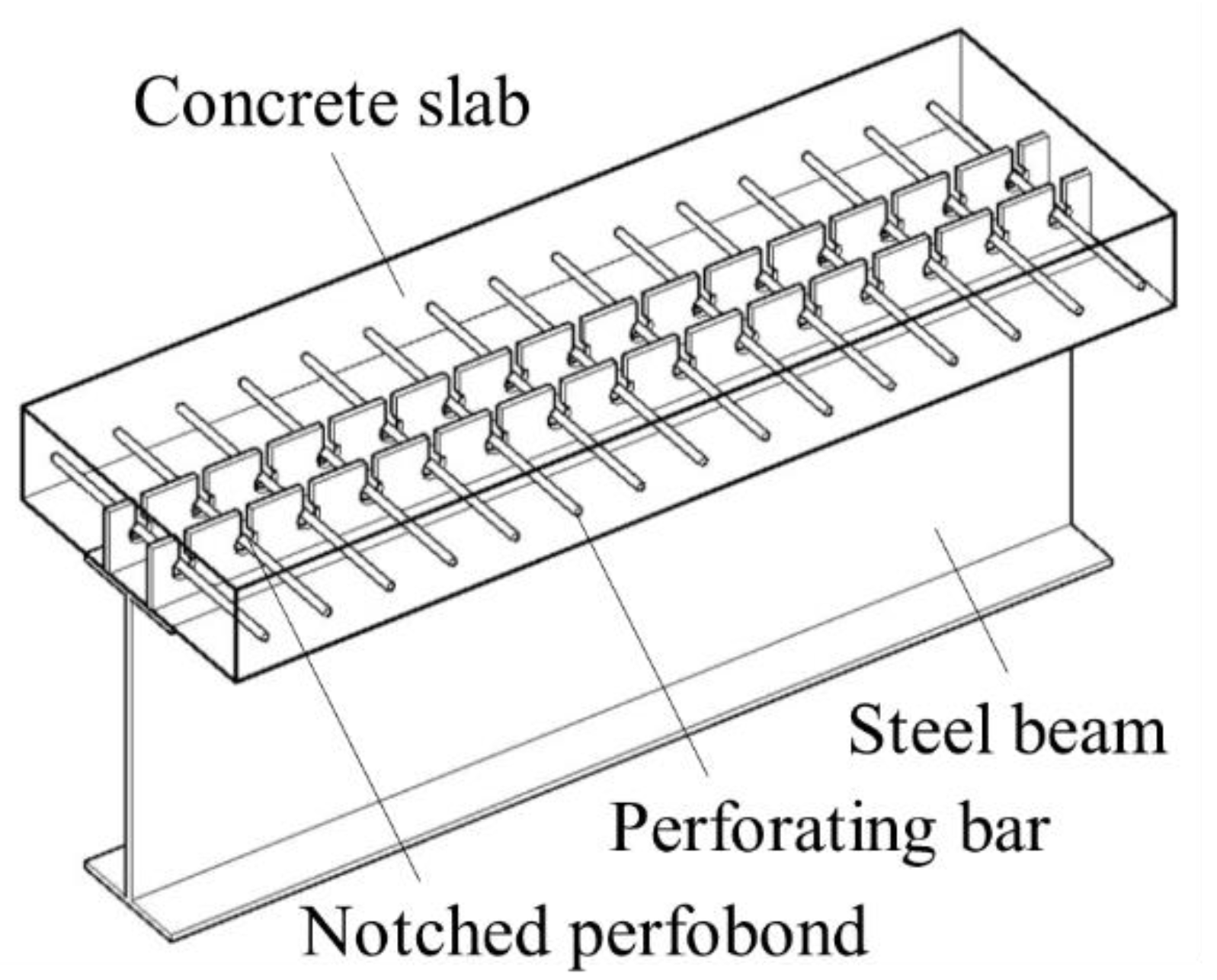
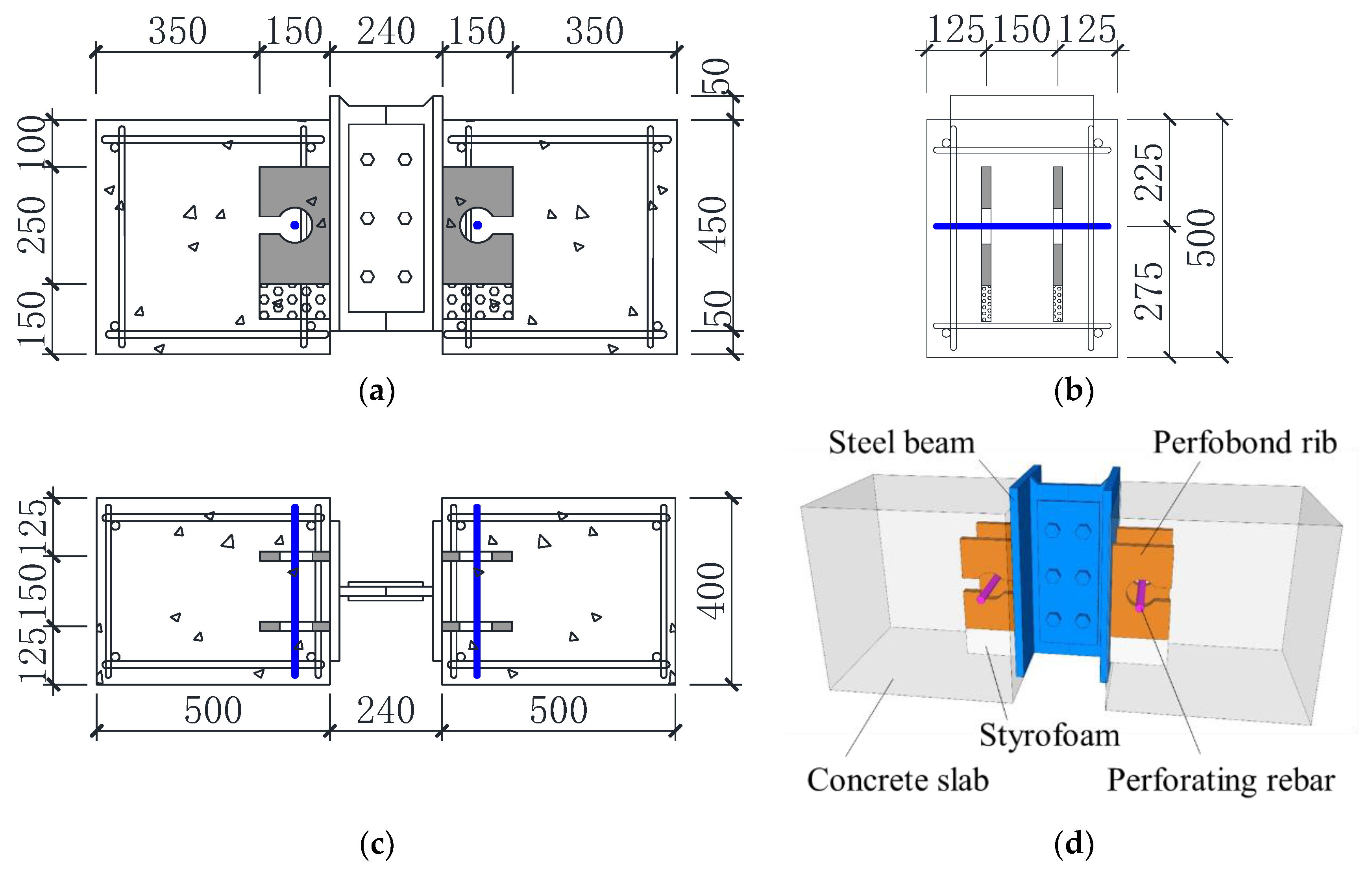
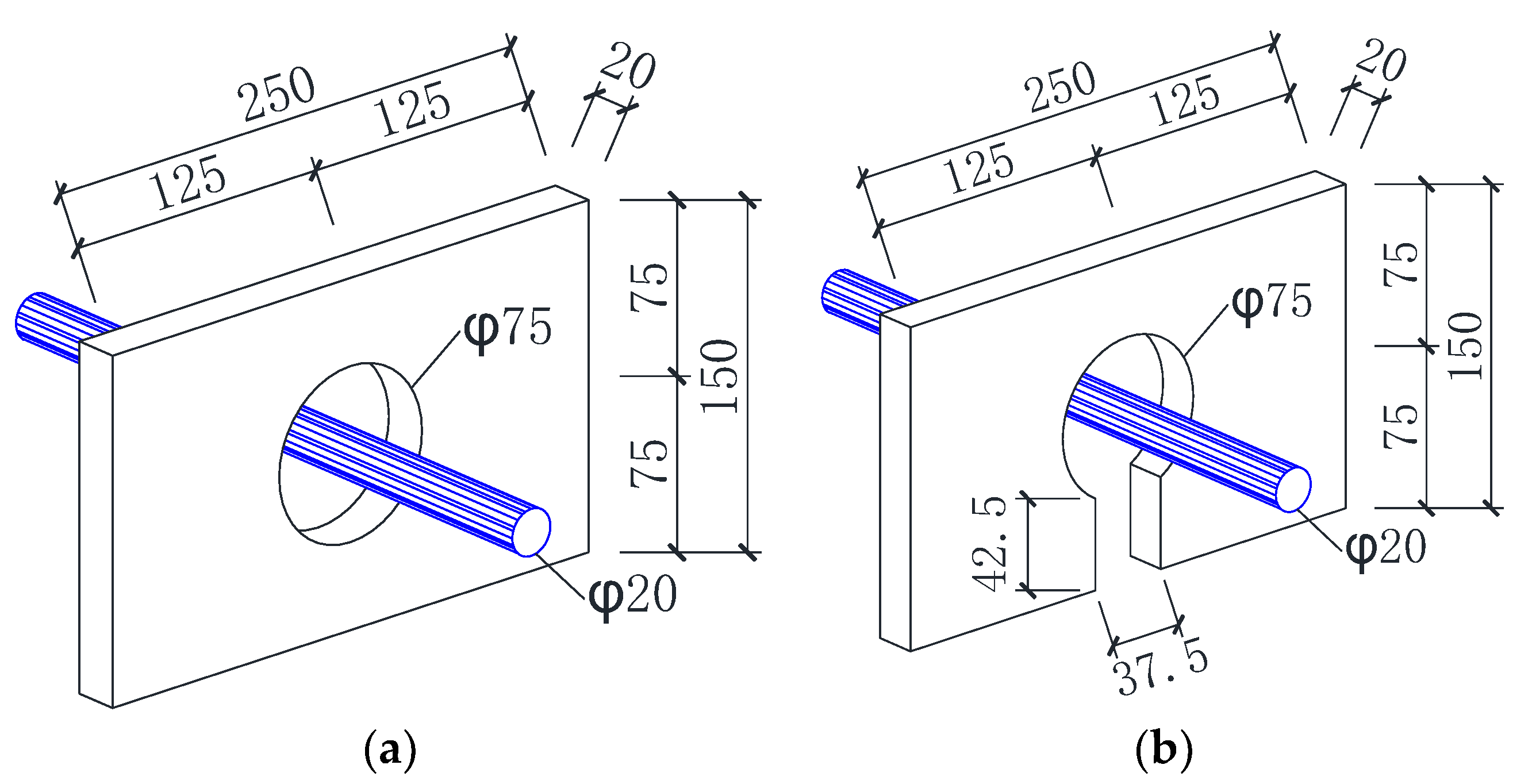


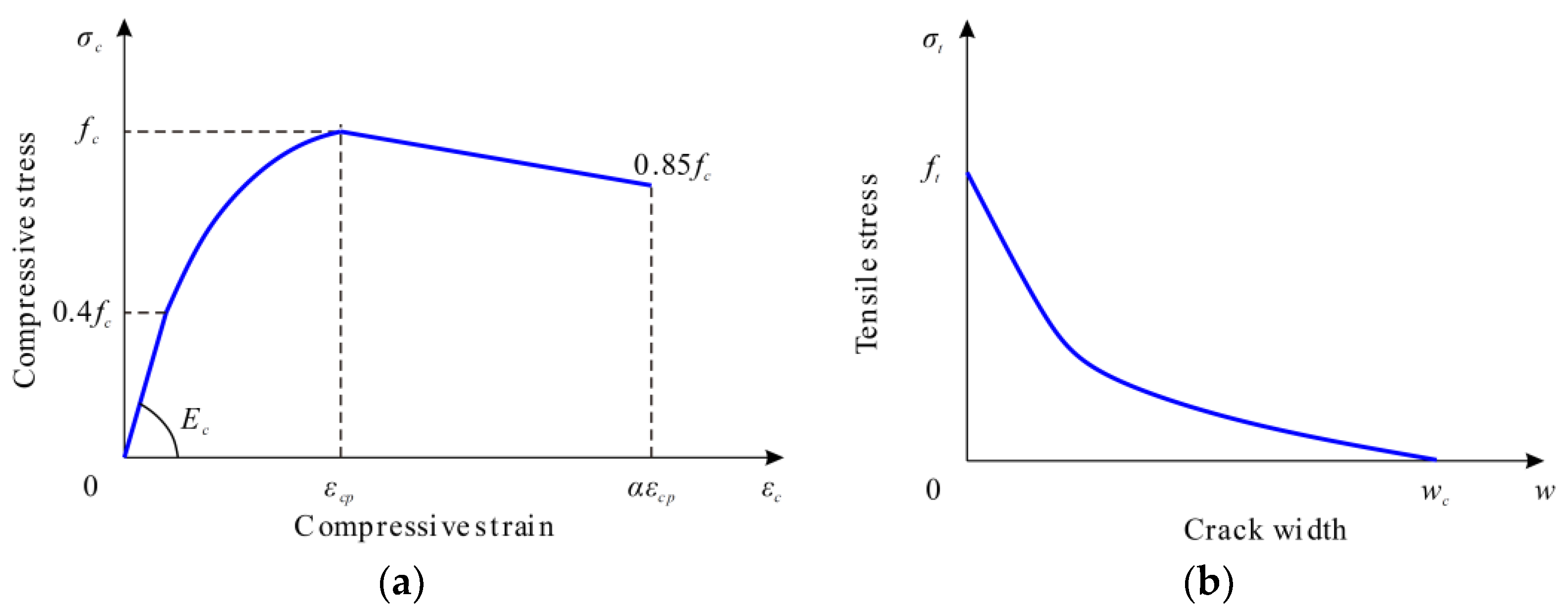


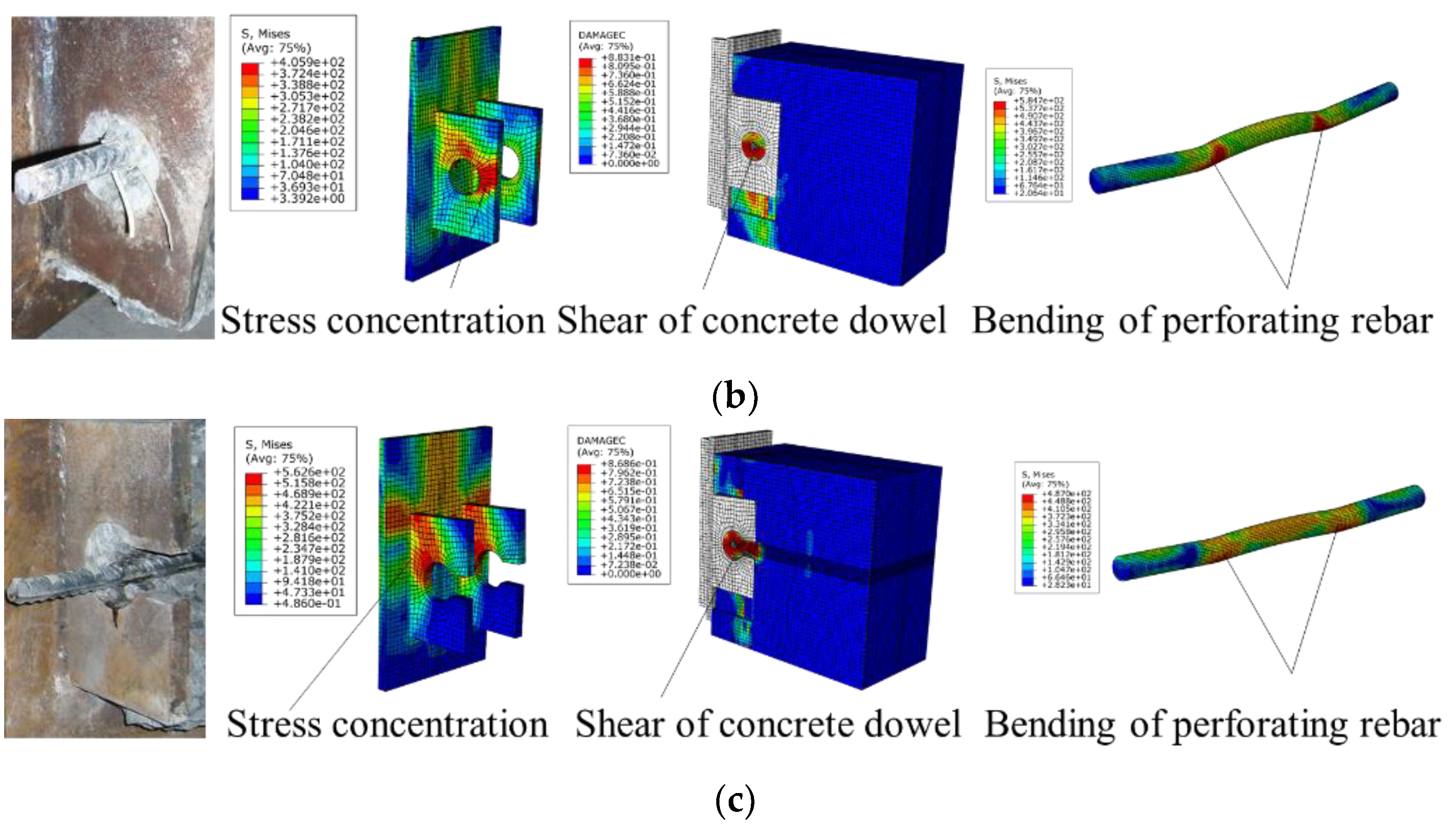
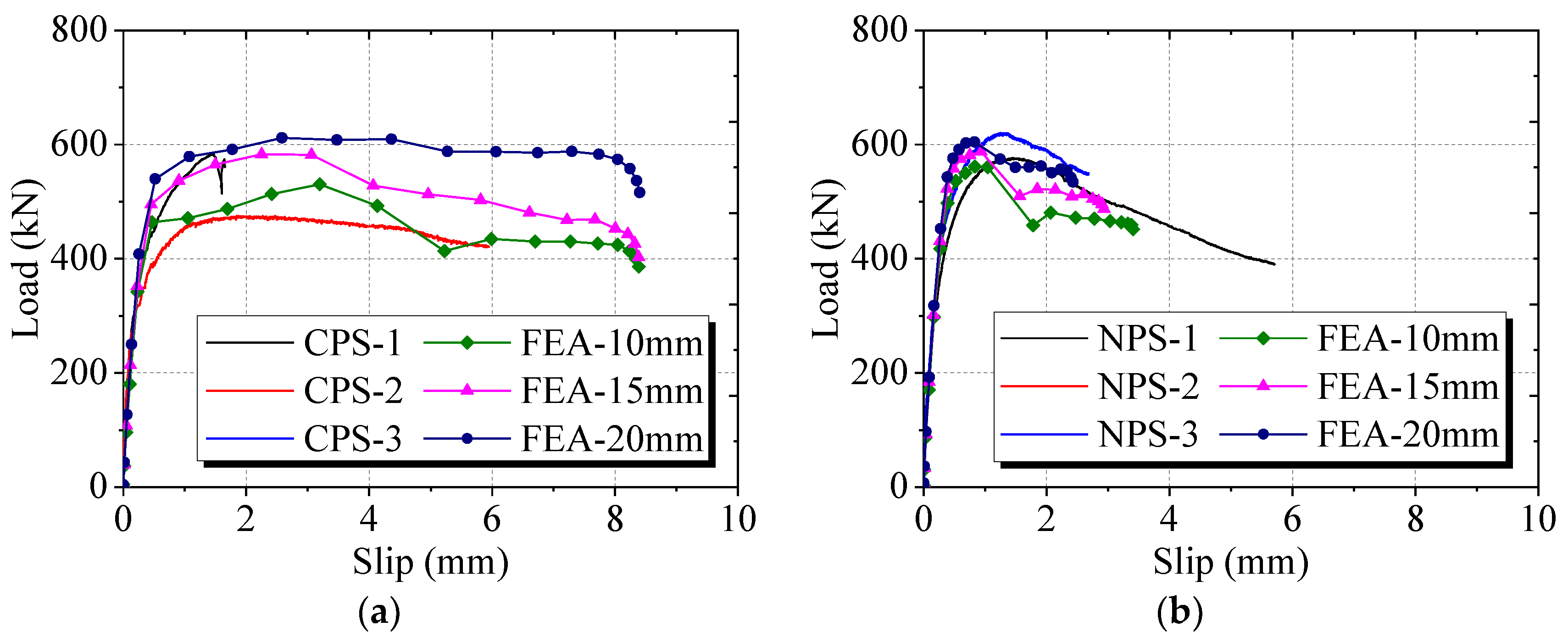

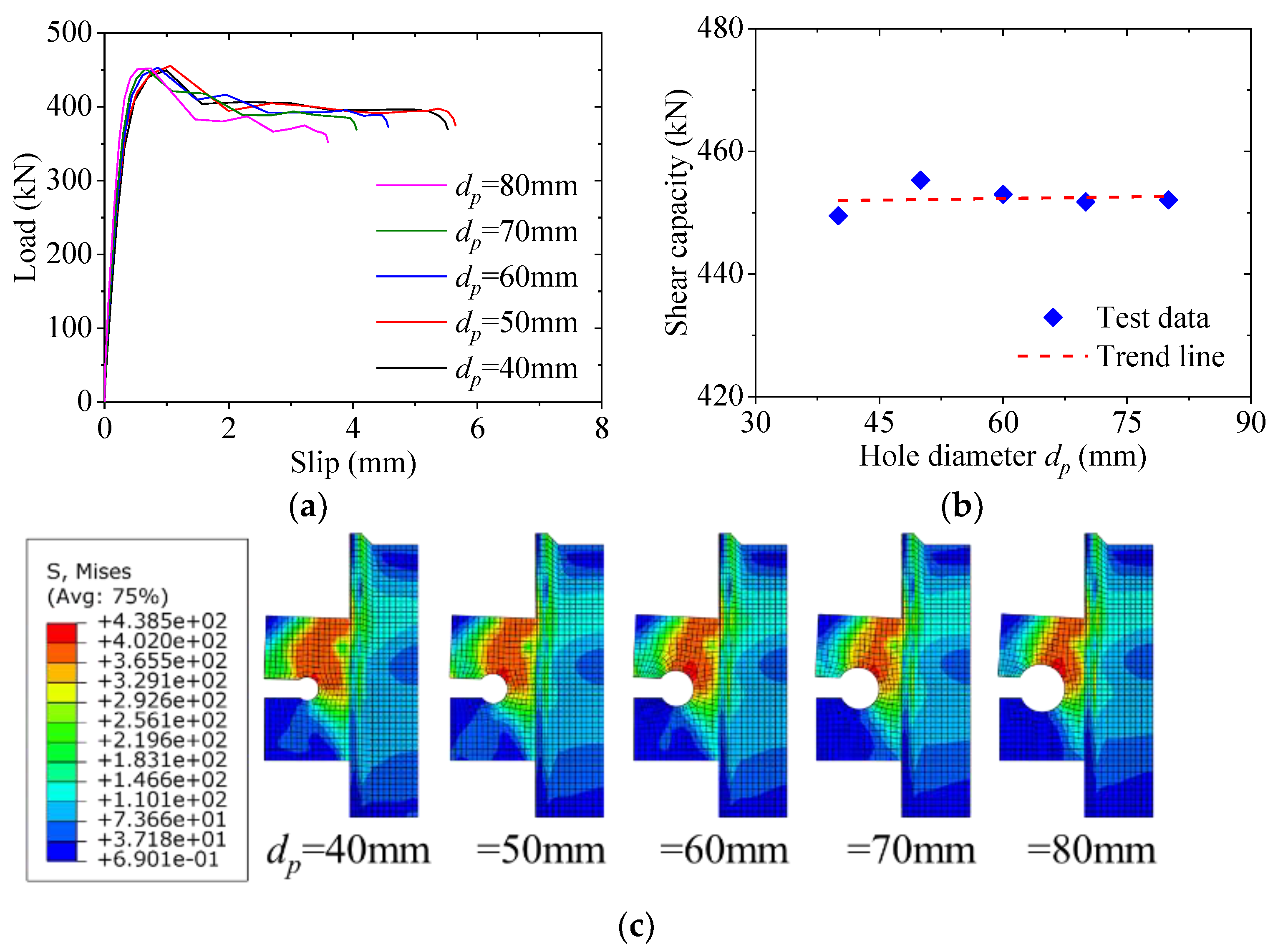
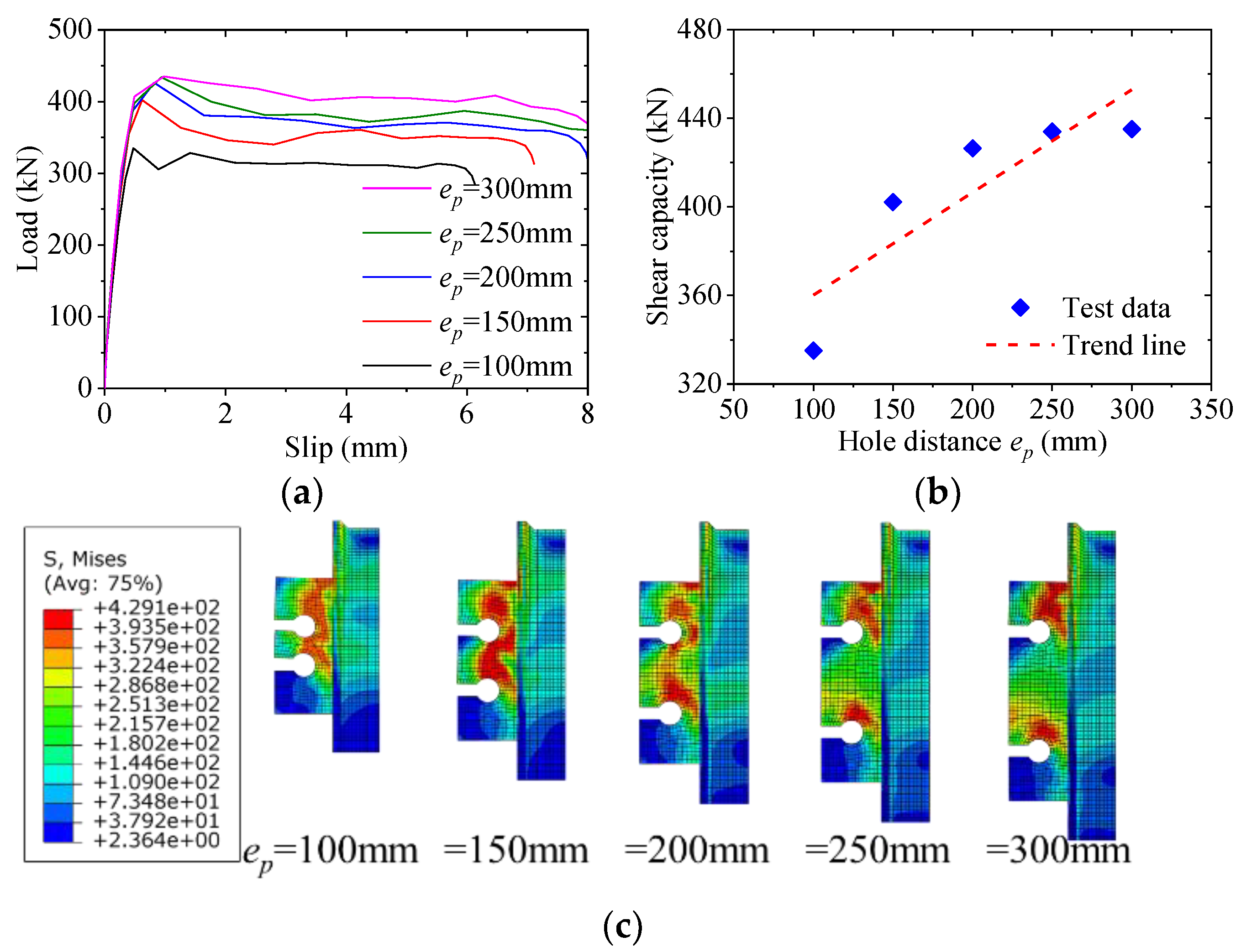
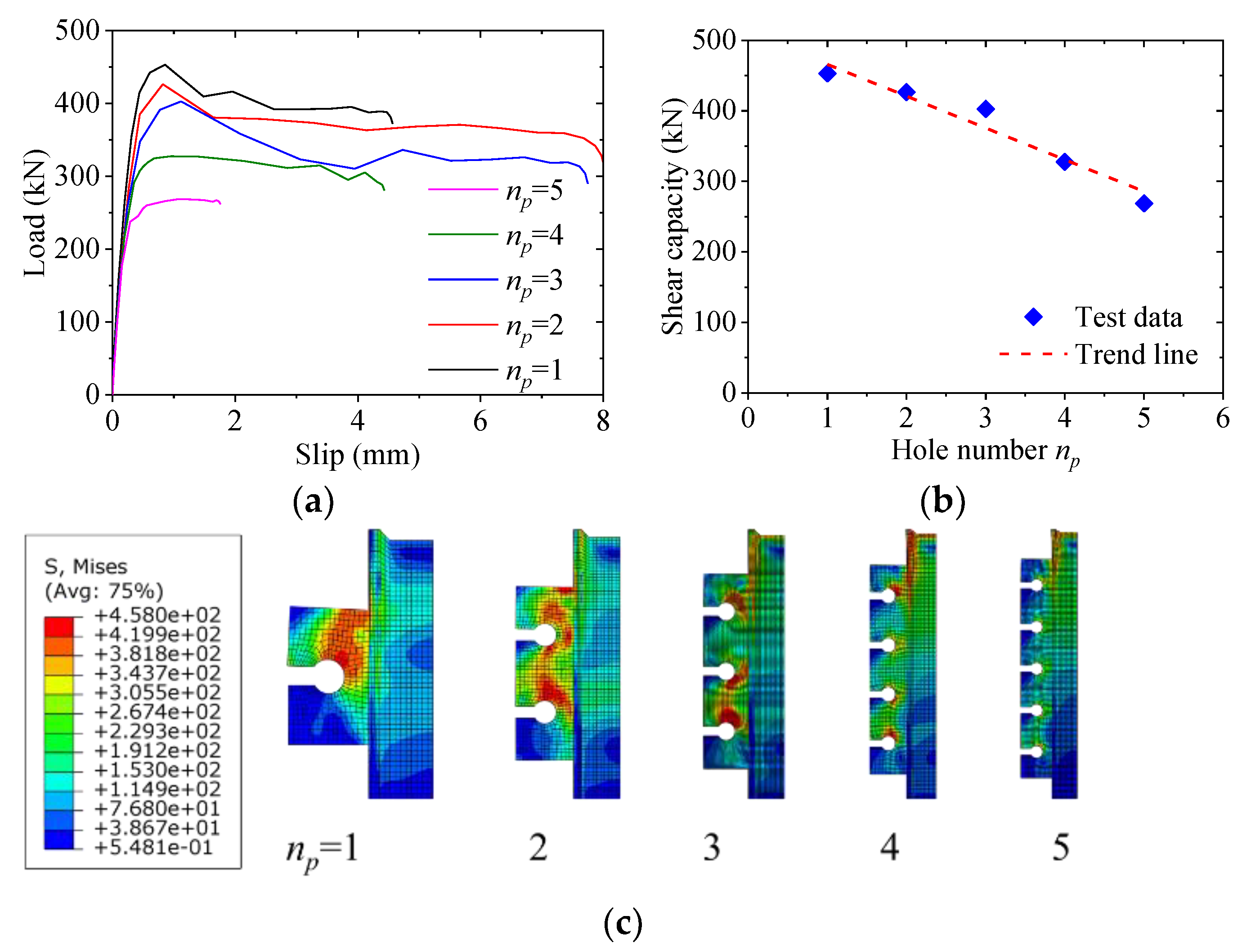
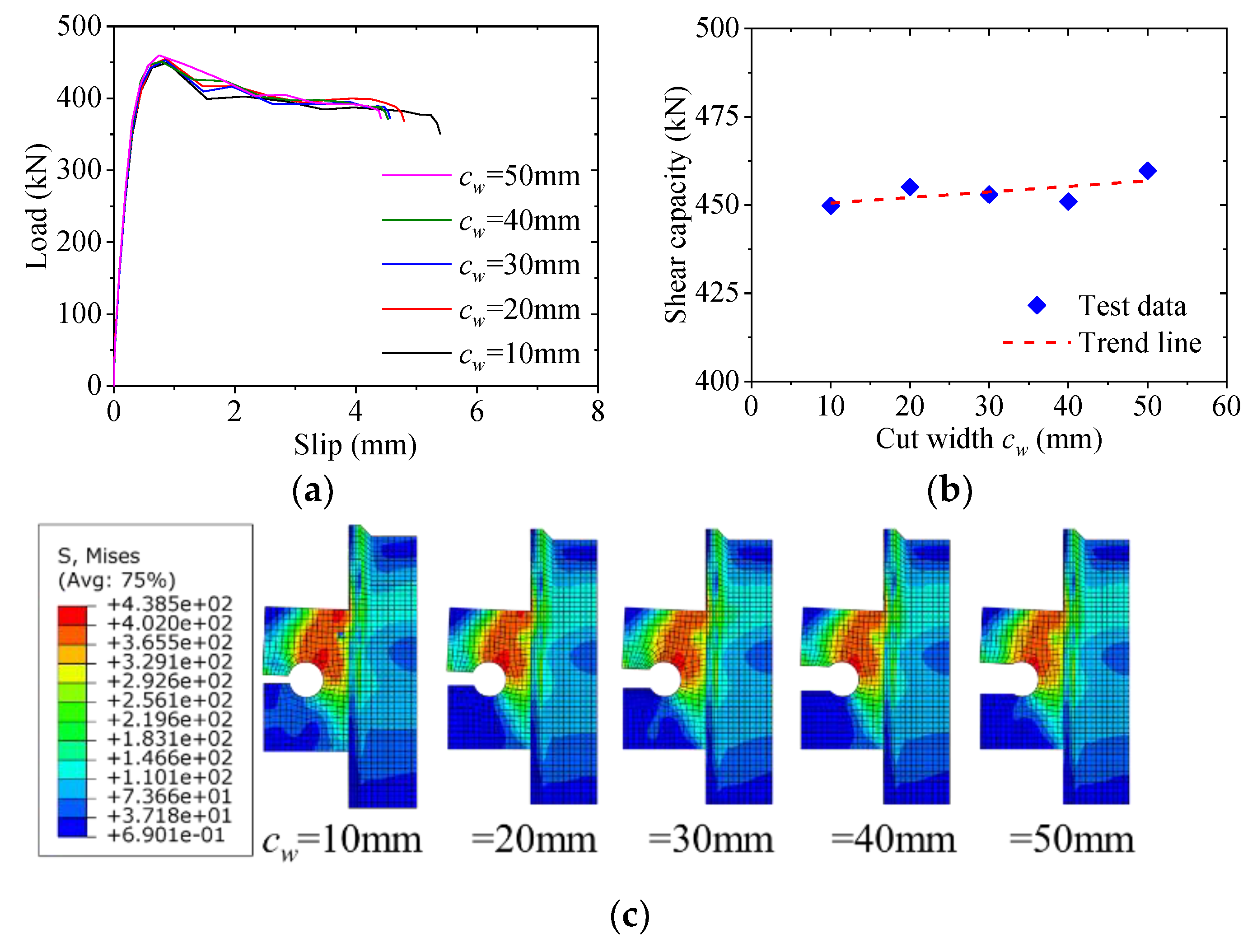
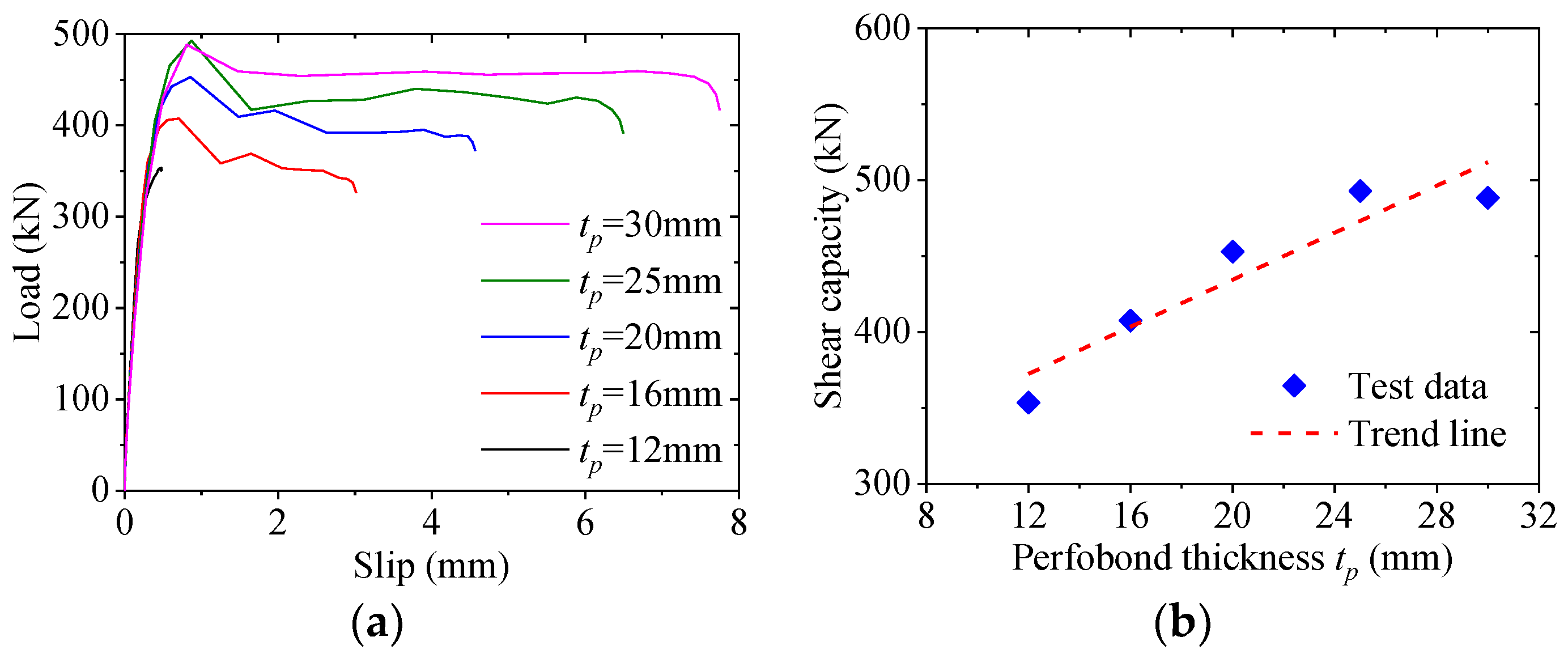
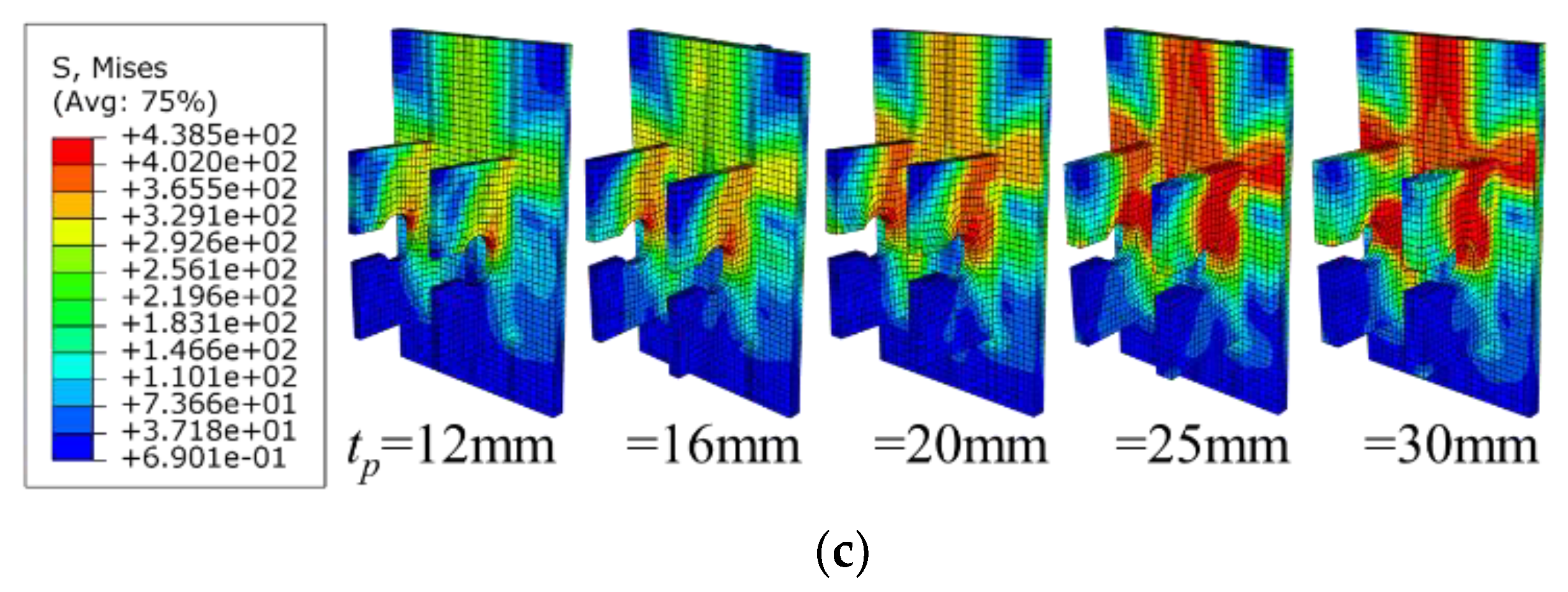
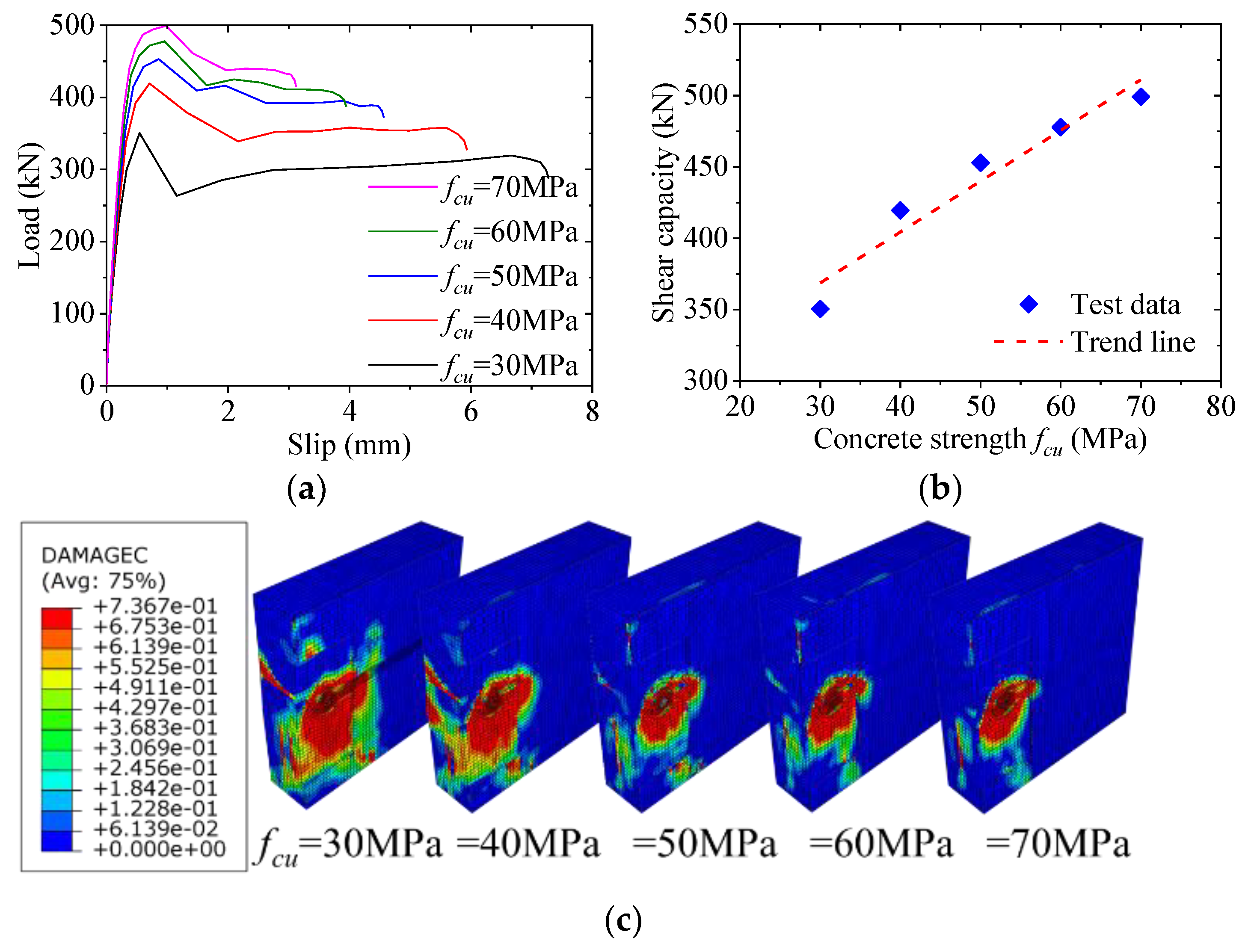
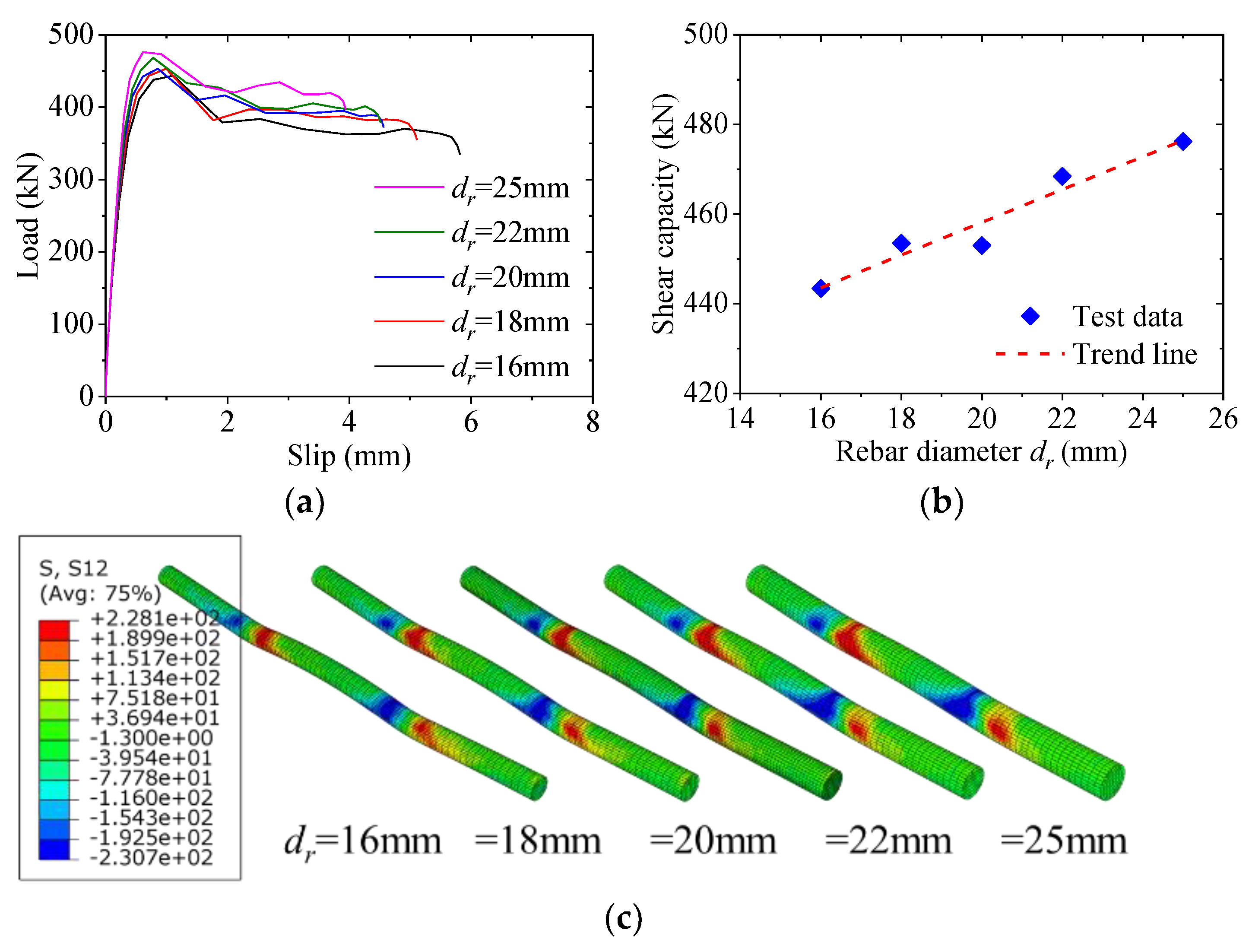
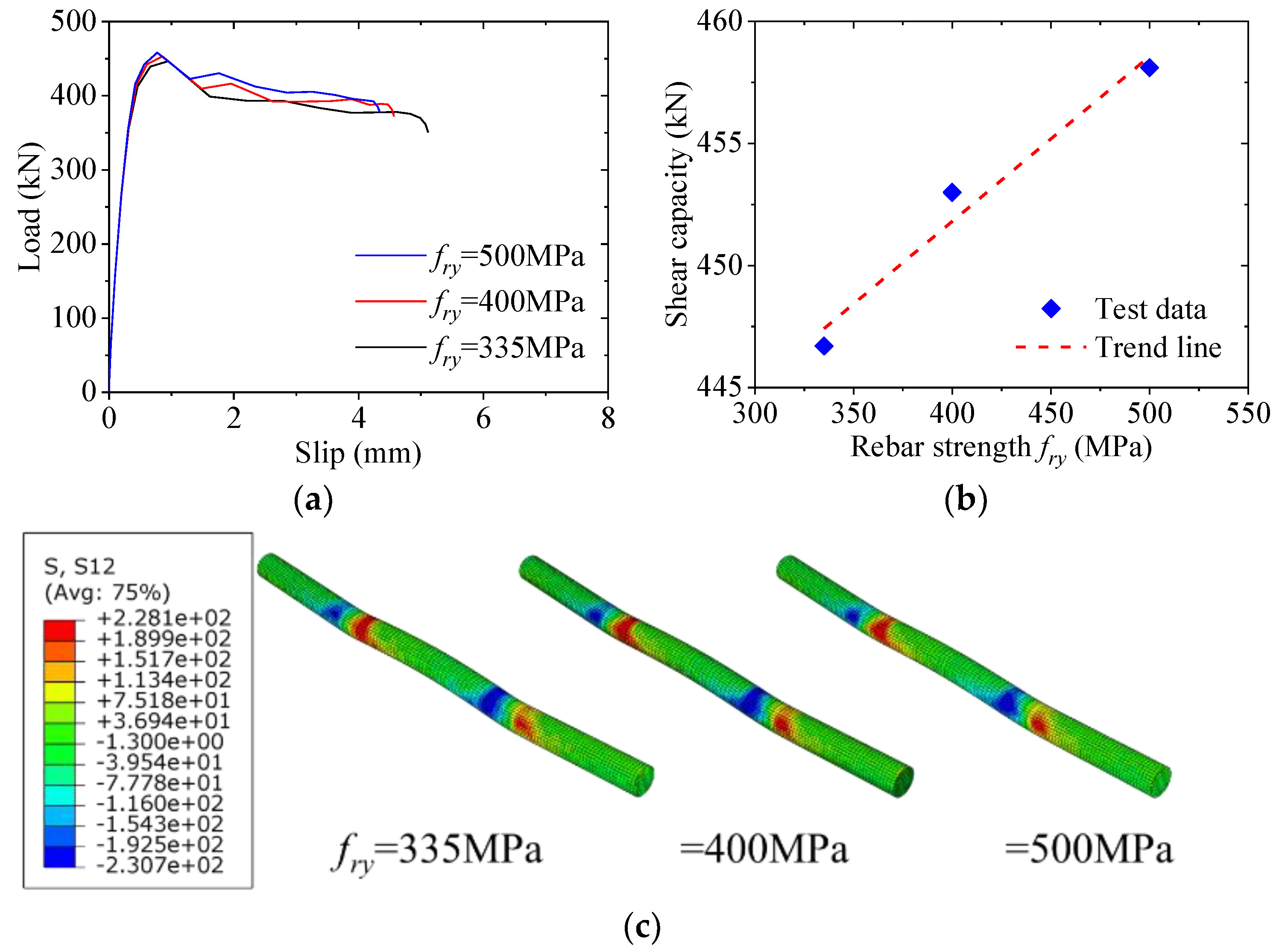
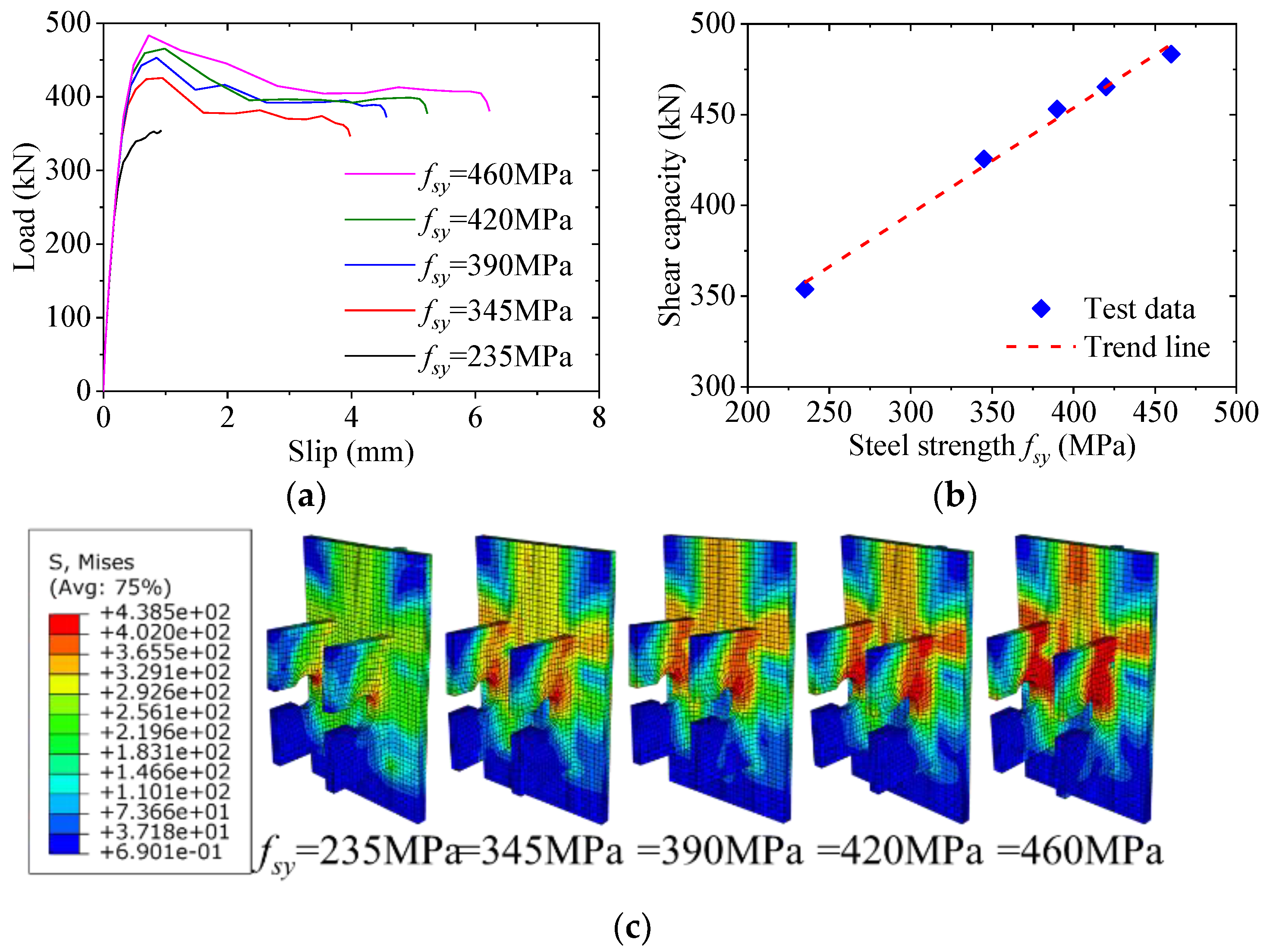

| Specimen | dp (mm) | cw (mm) | cw/dp | dr (mm) | lp (mm) | hp (mm) | tp (mm) | Notch |
|---|---|---|---|---|---|---|---|---|
| CPS–1 | 75 | - | 0 | 20 | 250 | 150 | 20 | No |
| CPS–2 | 75 | - | 0 | 20 | 250 | 150 | 20 | No |
| CPS–3 | 75 | - | 0 | 20 | 250 | 150 | 20 | No |
| NPS–1 | 75 | 37.5 | 0.5 | 20 | 250 | 150 | 20 | Yes |
| NPS–2 | 75 | 37.5 | 0.5 | 20 | 250 | 150 | 20 | Yes |
| NPS–3 | 75 | 37.5 | 0.5 | 20 | 250 | 150 | 20 | Yes |
| Specimen. | Test | Analysis | Comparison | |||||
|---|---|---|---|---|---|---|---|---|
| Vu,i (kN) | Vu,avg (kN) | Vu,fea1 (kN) | Vu,fea2 (kN) | Vu,fea3 (kN) | Vu,fea1/Vu,avg | Vu,fea2/Vu,avg | Vu,fea3/Vu,avg | |
| CPS–1 | 583.4 | |||||||
| CPS–2 | 474.9 | 524.6 | 530.5 | 582.9 | 611.7 | 101% | 111% | 117% |
| CPS–3 | 515.4 | |||||||
| NPS–1 | 575.4 | |||||||
| NPS–2 | 541.5 | 578.7 | 561.3 | 587.6 | 604.5 | 97% | 102% | 105% |
| NPS–3 | 619.2 | |||||||
| Model | dp (mm) | ep (mm) | np | cw (mm) | tp (mm) | fcu (MPa) | dr (mm) | fry (MPa) | fsy (MPa) | Vu (kN) |
|---|---|---|---|---|---|---|---|---|---|---|
| DP–40 | 40 | — | 1 | 30 | 20 | 50 | 20 | 400 | 390 | 449.5 |
| DP–50 | 50 | — | 1 | 30 | 20 | 50 | 20 | 400 | 390 | 455.3 |
| DP–60 | 60 | — | 1 | 30 | 20 | 50 | 20 | 400 | 390 | 453.0 |
| DP–70 | 70 | — | 1 | 30 | 20 | 50 | 20 | 400 | 390 | 451.8 |
| DP–80 | 80 | — | 1 | 30 | 20 | 50 | 20 | 400 | 390 | 452.1 |
| EP–100 | 60 | 100 | 2 | 30 | 20 | 50 | 20 | 400 | 390 | 335.1 |
| EP–150 | 60 | 150 | 2 | 30 | 20 | 50 | 20 | 400 | 390 | 402.2 |
| EP–200 | 60 | 200 | 2 | 30 | 20 | 50 | 20 | 400 | 390 | 426.4 |
| EP–250 | 60 | 250 | 2 | 30 | 20 | 50 | 20 | 400 | 390 | 434.0 |
| EP–300 | 60 | 300 | 2 | 30 | 20 | 50 | 20 | 400 | 390 | 435.1 |
| NP–1 | 60 | — | 1 | 30 | 20 | 50 | 20 | 400 | 390 | 453.0 |
| NP–2 | 60 | 200 | 2 | 30 | 20 | 50 | 20 | 400 | 390 | 426.4 |
| NP–3 | 60 | 200 | 3 | 30 | 20 | 50 | 20 | 400 | 390 | 402.8 |
| NP–4 | 60 | 200 | 4 | 30 | 20 | 50 | 20 | 400 | 390 | 327.5 |
| NP–5 | 60 | 200 | 5 | 30 | 20 | 50 | 20 | 400 | 390 | 268.8 |
| CW–10 | 60 | — | 1 | 10 | 20 | 50 | 20 | 400 | 390 | 449.8 |
| CW–20 | 60 | — | 1 | 20 | 20 | 50 | 20 | 400 | 390 | 455.1 |
| CW–30 | 60 | — | 1 | 30 | 20 | 50 | 20 | 400 | 390 | 453.0 |
| CW–40 | 60 | — | 1 | 40 | 20 | 50 | 20 | 400 | 390 | 451.0 |
| CW–50 | 60 | — | 1 | 50 | 20 | 50 | 20 | 400 | 390 | 459.7 |
| TP–12 | 60 | — | 1 | 30 | 12 | 50 | 20 | 400 | 390 | 353.6 |
| TP–16 | 60 | — | 1 | 30 | 16 | 50 | 20 | 400 | 390 | 407.6 |
| TP–20 | 60 | — | 1 | 30 | 20 | 50 | 20 | 400 | 390 | 453.0 |
| TP–25 | 60 | — | 1 | 30 | 25 | 50 | 20 | 400 | 390 | 493.0 |
| TP–30 | 60 | — | 1 | 30 | 30 | 50 | 20 | 400 | 390 | 488.5 |
| CU–30 | 60 | — | 1 | 30 | 20 | 30 | 20 | 400 | 390 | 350.3 |
| CU–40 | 60 | — | 1 | 30 | 20 | 40 | 20 | 400 | 390 | 419.5 |
| CU–50 | 60 | — | 1 | 30 | 20 | 50 | 20 | 400 | 390 | 453.0 |
| CU–60 | 60 | — | 1 | 30 | 20 | 60 | 20 | 400 | 390 | 477.8 |
| CU–70 | 60 | — | 1 | 30 | 20 | 70 | 20 | 400 | 390 | 499.2 |
| DR–16 | 60 | — | 1 | 30 | 20 | 50 | 16 | 400 | 390 | 443.4 |
| DR–18 | 60 | — | 1 | 30 | 20 | 50 | 18 | 400 | 390 | 453.5 |
| DR–20 | 60 | — | 1 | 30 | 20 | 50 | 20 | 400 | 390 | 453.0 |
| DR–22 | 60 | — | 1 | 30 | 20 | 50 | 22 | 400 | 390 | 468.4 |
| DR–25 | 60 | — | 1 | 30 | 20 | 50 | 25 | 400 | 390 | 476.2 |
| RY–335 | 60 | — | 1 | 30 | 20 | 50 | 20 | 335 | 390 | 446.7 |
| RY–400 | 60 | — | 1 | 30 | 20 | 50 | 20 | 400 | 390 | 453.0 |
| RY–500 | 60 | — | 1 | 30 | 20 | 50 | 20 | 500 | 390 | 458.1 |
| SY–235 | 60 | — | 1 | 30 | 20 | 50 | 20 | 400 | 235 | 353.8 |
| SY–345 | 60 | — | 1 | 30 | 20 | 50 | 20 | 400 | 345 | 425.6 |
| SY–390 | 60 | — | 1 | 30 | 20 | 50 | 20 | 400 | 390 | 453.0 |
| SY–420 | 60 | — | 1 | 30 | 20 | 50 | 20 | 400 | 420 | 465.4 |
| SY–460 | 60 | — | 1 | 30 | 20 | 50 | 20 | 400 | 460 | 483.4 |
© 2019 by the authors. Licensee MDPI, Basel, Switzerland. This article is an open access article distributed under the terms and conditions of the Creative Commons Attribution (CC BY) license (http://creativecommons.org/licenses/by/4.0/).
Share and Cite
Zheng, S.; Liu, Y.; Liu, Y.; Zhao, C. Experimental and Numerical Study on Shear Resistance of Notched Perfobond Shear Connector. Materials 2019, 12, 341. https://doi.org/10.3390/ma12030341
Zheng S, Liu Y, Liu Y, Zhao C. Experimental and Numerical Study on Shear Resistance of Notched Perfobond Shear Connector. Materials. 2019; 12(3):341. https://doi.org/10.3390/ma12030341
Chicago/Turabian StyleZheng, Shuangjie, Yuqing Liu, Yangqing Liu, and Chen Zhao. 2019. "Experimental and Numerical Study on Shear Resistance of Notched Perfobond Shear Connector" Materials 12, no. 3: 341. https://doi.org/10.3390/ma12030341
APA StyleZheng, S., Liu, Y., Liu, Y., & Zhao, C. (2019). Experimental and Numerical Study on Shear Resistance of Notched Perfobond Shear Connector. Materials, 12(3), 341. https://doi.org/10.3390/ma12030341





